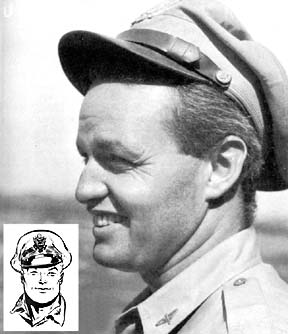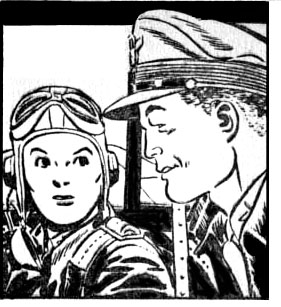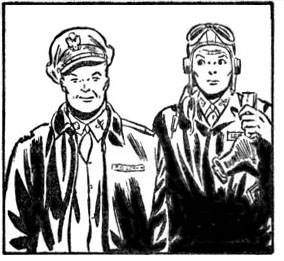
The Comic-Strip Major and His Joker Squadron



The Major Flip Corkin that Americans knew was character created by comic-strip artist Milton Caniff that appeared regularly in Caniff's popular "Terry and the Pirates" (retitled "Terry Lee, Flight Officer USA"), a handsome, adventurous, moral, worldly young officer, somewhat of a rebel, a patriotic kicktrace who still honored the military codes of conduct. In short, Corkin was a bit like Willie Loman's brother Ben in "Death of a Salesman," a favorite-uncle figure to the young AAF pilots in the Terry strip, certainly a role model, who weaved in and out of the storyline. He represented the modest, but dashing, hero that Americans enjoyed and, at that time in the war, needed.

The one that Americans didn't know as well was USAAF Major Philip Cochran, on whom Caniff closely based his character. "Flip Corkin" was real, a Pennsylvania lad who embraced aviation at an early age, joined ROTC at Ohio State (where he met Milton Caniff), and went into the Air Force when the war broke out. Although trained as a fighter pilot, because of his natural talent as a leader and organizer, Cochran was instead given a P-40 squadron to mold into a fighting unit.

The squadron's mascot was a gaming rooster, and its insignia (designed by Caniff) was a fighting cock with a chip on its shoulder. As a trained group the squadron was dispatched to North Africa, but without their commander, who was hospitalized in a run-down state of exhaustion. Cochran had so badly overworked himself in shaping his squadron that he had a case of pre-combat combat fatigue!

Depressed about being left behind, fortune stepped in when General Joseph K Cannon selected Cochran to take charge of a group of 35 P-40s and their pilots, replacements for various squadrons already in Africa, to cross the Atlantic on a British carrier.

Reportedly the P-40s were transferred by cranes to some sort of towed barge that had been equipped with launching mechanisms similar to those used on navy ships and, using this catapult system, the P-40s were flung into the air, with pilots who had zero training in this novel method. It was said that, miraculously, only four P-40s were lost to the Mediterranean, and the rest somehow survived the launch to land at an onshore airfield!
 Ashore they found confusion. The invasion was in its early stages, and organization systems were fragile if not nonexistent. Finding no assignments and no place to go, Cochran decided to keep the group together and headed off in the general direction of the war. By inquiring locally as they flew short hops, they eventually found an Army infantry unit at a flat spot in the desert who were more than happy to have their own air cover.
Ashore they found confusion. The invasion was in its early stages, and organization systems were fragile if not nonexistent. Finding no assignments and no place to go, Cochran decided to keep the group together and headed off in the general direction of the war. By inquiring locally as they flew short hops, they eventually found an Army infantry unit at a flat spot in the desert who were more than happy to have their own air cover.

Cochran immediately set up a training schedule for his recruits, commandeered infantry trucks to find supplies, fuel, and ammunition from wherever they could be borrowed or pilfered, and in a few weeks had a cohesive fighting squadron. Being formed outside of Air Force jurisdiction and having no official number, they dubbed themselves the "Joker Squadron," and adopted bright red scarves are their symbol.

When AAF Command finally learned of their existence, HQ was unsure of exactly what they had, but it was apparently a trained squadron to add to the roster, so Cochran was ordered to take his men as replacements to Rabat—then in the hands of the Vichy French, who had no interest in fighting the Allies.

From there the Jokers made flights across the desert and along the coastline, trying to locate something, anything, to combat, but with no success. Frustrated, and still without a squadron number, Cochran saw the chance for independent operation as a guerilla air force and took his rag-tag bunch to a remote spot in Southern Tunisia, where only small British Army units were stationed to guard against Rommel using that corridor as an escape route.

Independent fighting was the thing Cochran was most happy with, and his Jokers made the most of it by dogfighting German and Italian planes that strayed their way, strafing enemy convoys and bombing artillery posts, and generally making their irritating presence known. His group began looking more like outcasts than soldiers, military routine fell by the wayside, shaving was a lost art, and uniforms of the day were leather jackets and wrinkled suntans. Aircraft maintenance was haphazard, mostly by British truck mechanics, and supplies an ongoing problem, but with Yankee ingenuity those were dealt with.
 Cochran drove his men, and himself, leading flights at every opportunity. They flew 30 to 40 missions each month, extending their territory northward, and combat fatigue became ritual, but the Jokers kept up the pressure on the enemy. Cochran had spotted a German field headquarters building at Kairouan that had somehow gone unscathed in bombings by B-25 squadrons and it bothered him, so one morning he made a pre-dawn flight with a 500-pound bomb strapped to his P-40's belly.
Cochran drove his men, and himself, leading flights at every opportunity. They flew 30 to 40 missions each month, extending their territory northward, and combat fatigue became ritual, but the Jokers kept up the pressure on the enemy. Cochran had spotted a German field headquarters building at Kairouan that had somehow gone unscathed in bombings by B-25 squadrons and it bothered him, so one morning he made a pre-dawn flight with a 500-pound bomb strapped to his P-40's belly.

Dune-hopping in the pale light, he made his bombing run so low he had to pull up to get over his target. Over his shoulder he saw the building go up in a cloud of smoke. "Just like in a movie!" he described it. At altitude on the way home, a Focke-Wulf suddenly came from nowhere and put cannon rounds through his rudder and one aileron, forcing the P-40 into a shallow circular dive. Realizing if the German saw the opportunity and came back for a second pass, he would be a goner, he turned and went at the Fw.190 head-on, firing his guns and holding full opposite aileron and rudder to keep going straight. The German must have suspected a trick, because he broke off to fly away, and Cochran resumed his descent to the inevitable crash-landing.

As the Jokers' combat record grew, folk legends about their deeds began spreading northward, and before long AAF Command became interested in their activities. Brought back into the family and finally numbered, a thread of communication and supply was established. AAF's North Africa Commander, General James Doolittle, flew down to see for himself what all the ruckus was about. Impressed by what he found, he asked Cochran what he needed.

"More planes!" was the reply.

Suddenly more planes, pilots, and ground troops showed up at their airfield—even some attack bombers. Cochran's operation expanded to 2,000 men, and there were weekly visits by Doolittle to keep up with Cochran's development of ground support, out of which grew the concept of a tactical air force to deal with specific jobs.
 Despite renewed support, living conditions remained marginal at best. Food was mainly bland British field-rations. Between missions the men were faced with incredible boredom in the middle of nowhere. At first they had slept in foxholes until they took over a ravine, in which they dug caves. Some of those were expanded into caverns if only for want of something to do while sitting out sandstorms. They survived like cave-dwellers, and Cochran admitted to one stretch of six weeks when he didn't take off his clothes at all.
Despite renewed support, living conditions remained marginal at best. Food was mainly bland British field-rations. Between missions the men were faced with incredible boredom in the middle of nowhere. At first they had slept in foxholes until they took over a ravine, in which they dug caves. Some of those were expanded into caverns if only for want of something to do while sitting out sandstorms. They survived like cave-dwellers, and Cochran admitted to one stretch of six weeks when he didn't take off his clothes at all.

General Cannon arrived one time and saw some of the pilots in dirty undershirts and tattered British shorts won in poker games. "Are you by any remote chance American Army officers?" he demanded of one of them.

"Oh, yes, Sir."

"You mean to tell me that Cochran lets you go around looking like that?" he exploded.

"Hell, General," was the reply. "You ought to see him. He's dirtier than we are!"

AAF Command was too short of air power to relieve the Joker Squadron, so the men fought on, ate their British rations, and crawled into their caves each night. But daily sick-call lines grew longer, morale sank lower, and when one of the pilots shot himself, Command finally relented and sent the men home.

The Jokers existed only in legend. Its pilots were so badly spent as to never be sent into combat again, but for Cochran it was just the end of one episode. As a lieutenant colonel, and later a "bird" colonel, he went on to more adventures in LtGen Claire Chennault's China Air Force as commander of the First Air Commando Group in Burma, with many of his exploits being documented in Caniff's daily newspaper comic strips as the handiwork of Flip Corkin. (— K O Eckland)
— Clips from "Terry and the Pirates" courtesy of Famous Artists Syndicate, Chicago.
— USAAF photo liberated from Back To Mandalay, Lowell Thomas, 1951.
— Ref: Basic data from Dale K Robinson, 15 Aug 1998, based on 1975 interviews with Cochran (cf: USAF Oral History #K239.0512-876).
|

 Ashore they found confusion. The invasion was in its early stages, and organization systems were fragile if not nonexistent. Finding no assignments and no place to go, Cochran decided to keep the group together and headed off in the general direction of the war. By inquiring locally as they flew short hops, they eventually found an Army infantry unit at a flat spot in the desert who were more than happy to have their own air cover.
Ashore they found confusion. The invasion was in its early stages, and organization systems were fragile if not nonexistent. Finding no assignments and no place to go, Cochran decided to keep the group together and headed off in the general direction of the war. By inquiring locally as they flew short hops, they eventually found an Army infantry unit at a flat spot in the desert who were more than happy to have their own air cover.
 Cochran drove his men, and himself, leading flights at every opportunity. They flew 30 to 40 missions each month, extending their territory northward, and combat fatigue became ritual, but the Jokers kept up the pressure on the enemy. Cochran had spotted a German field headquarters building at Kairouan that had somehow gone unscathed in bombings by B-25 squadrons and it bothered him, so one morning he made a pre-dawn flight with a 500-pound bomb strapped to his P-40's belly.
Cochran drove his men, and himself, leading flights at every opportunity. They flew 30 to 40 missions each month, extending their territory northward, and combat fatigue became ritual, but the Jokers kept up the pressure on the enemy. Cochran had spotted a German field headquarters building at Kairouan that had somehow gone unscathed in bombings by B-25 squadrons and it bothered him, so one morning he made a pre-dawn flight with a 500-pound bomb strapped to his P-40's belly.
 Despite renewed support, living conditions remained marginal at best. Food was mainly bland British field-rations. Between missions the men were faced with incredible boredom in the middle of nowhere. At first they had slept in foxholes until they took over a ravine, in which they dug caves. Some of those were expanded into caverns if only for want of something to do while sitting out sandstorms. They survived like cave-dwellers, and Cochran admitted to one stretch of six weeks when he didn't take off his clothes at all.
Despite renewed support, living conditions remained marginal at best. Food was mainly bland British field-rations. Between missions the men were faced with incredible boredom in the middle of nowhere. At first they had slept in foxholes until they took over a ravine, in which they dug caves. Some of those were expanded into caverns if only for want of something to do while sitting out sandstorms. They survived like cave-dwellers, and Cochran admitted to one stretch of six weeks when he didn't take off his clothes at all.